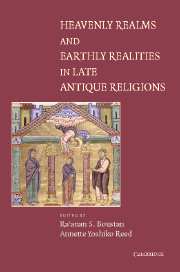Book contents
- Frontmatter
- Contents
- Preface
- List of Contributors
- Introduction: “In Heaven as It Is on Earth”
- PART ONE BETWEEN EARTH AND HEAVEN
- PART TWO INSTITUTIONALIZING HEAVEN
- 6 Earthly Sacrifice and Heavenly Incense: The Law of the Priesthood in Aramaic Levi and Jubilees
- 7 Who's on the Throne? Revelation in the Long Year
- 8 The Earthly Monastery and the Transformation of the Heavenly City in Late Antique Egypt
- 9 Contextualizing Heaven in Third-Century North Africa
- 10 Bringing the Heavenly Academy Down to Earth: Approaches to the Imagery of Divine Pedagogy in the East Syrian Tradition
- PART THREE TRADITION AND INNOVATION
- Select Bibliography
- Index
6 - Earthly Sacrifice and Heavenly Incense: The Law of the Priesthood in Aramaic Levi and Jubilees
Published online by Cambridge University Press: 14 July 2009
- Frontmatter
- Contents
- Preface
- List of Contributors
- Introduction: “In Heaven as It Is on Earth”
- PART ONE BETWEEN EARTH AND HEAVEN
- PART TWO INSTITUTIONALIZING HEAVEN
- 6 Earthly Sacrifice and Heavenly Incense: The Law of the Priesthood in Aramaic Levi and Jubilees
- 7 Who's on the Throne? Revelation in the Long Year
- 8 The Earthly Monastery and the Transformation of the Heavenly City in Late Antique Egypt
- 9 Contextualizing Heaven in Third-Century North Africa
- 10 Bringing the Heavenly Academy Down to Earth: Approaches to the Imagery of Divine Pedagogy in the East Syrian Tradition
- PART THREE TRADITION AND INNOVATION
- Select Bibliography
- Index
Summary
It is difficult to overstate the centrality of the Temple for Judaism in the Second Temple period. Yet, as far back as the Book of the Watchers in the third century b.c.e., many Jews were deeply critical of the priestly establishment that ran the Temple. Some critics, including the community at Qumran, came to view the Temple as defiled and were unwilling to participate in its cult. Even as they criticized the current state of affairs, however, they nonetheless continued to hold fast to the ideal of the Temple. One type of response to the distressing reality of the present appears in texts such as the Temple Scroll and 4QMMT, which offer detailed legal prescriptions for the proper governance of the Temple and its cult. Another type of response is attention to the heavenly Temple on which biblical tradition understands the Jerusalem Temple to be modeled. Thus, for example, the Book of the Watchers describes Enoch's ascent to heaven as if he were entering a Temple and treats the angels he encounters as priests, while the Songs of the Sabbath Sacrifice describes the liturgy of the heavenly Temple.
This paper begins on earth, with the “law of the priesthood” (13) in Aramaic Levi (13–61). Here Levi, the ancestor of all priests, receives instruction from his grandfather Isaac on a range of topics concerning proper cultic procedure.
- Type
- Chapter
- Information
- Heavenly Realms and Earthly Realities in Late Antique Religions , pp. 103 - 122Publisher: Cambridge University PressPrint publication year: 2004
- 3
- Cited by



